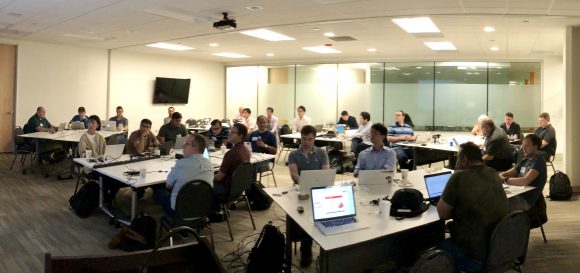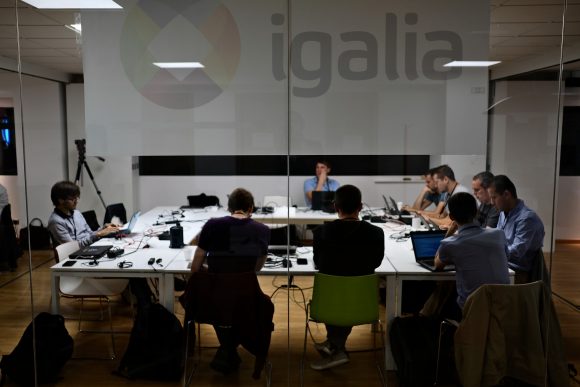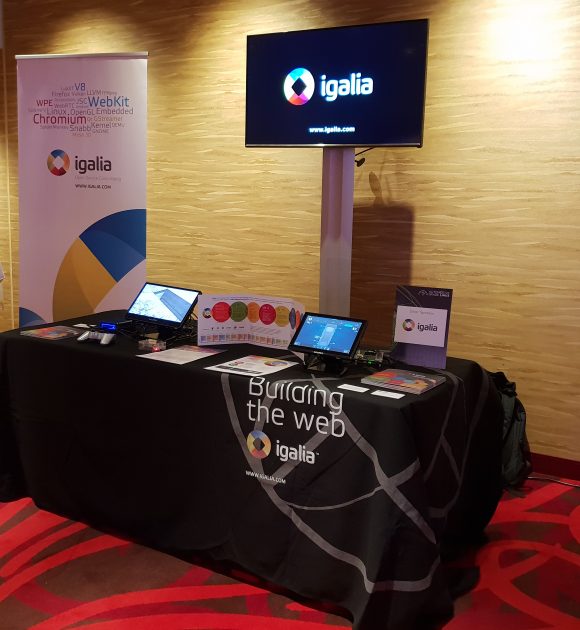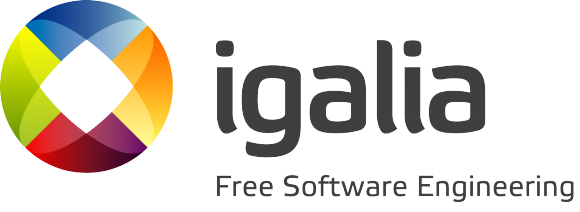As part of my job at Igalia, I have been attending 2-3 events per year. My role mostly as a Chromium stack engineer is not usually much demanding regarding conference trips, but they are quite important as an opportunity to meet collaborators and project mates.
This month has been a bit different, as I ended up visiting Santa Clara LG Silicon Valley Lab in California, Igalia headquarters in A Coruña, and Dresden. It was mostly because I got involved in the discussions for the web runtime implementation being developed by Igalia for AGL.
AGL f2f at LGSVL
It is always great to visit LG Silicon Valley Lab (Santa Clara, US), where my team is located. I have been participating for 6 years in the development of the webOS web stack you can most prominently enjoy in LG webOS smart TV.
One of the goals for next months at AGL is providing an efficient web runtime. In LGSVL we have been developing and maintaining WAM, the webOS web runtime. And as it was released with an open source license in webOS Open Source Edition, it looked like a great match for AGL. So my team did a proof of concept in May and it was succesful. At the same time Igalia has been working on porting Chromium browser to AGL. So, after some discussions AGL approved sponsoring my company, Igalia for porting the LG webOS web runtime to AGL.
As LGSVL was hosting the september 2018 AGL f2f meeting, Igalia sponsored my trip to the event.

So we took the opportunity to continue discussions and progress in the development of the WAM AGL port. And, as we expected, it was quite beneficial to unblock tasks like AGL app framework security integration, and the support of AGL latest official release, Funky Flounder. Julie Kim from Igalia attended the event too, and presented an update on the progress of the Ozone Wayland port.
The organization and the venue were great. Thanks to LGSVL!
Web Engines Hackfest 2018 at Igalia
Next trip was definitely closer. Just 90 minutes drive to our Igalia headquarters in A Coruña.

Igalia has been organizing this event since 2009. It is a cross-web-engine event, where engineers of Mozilla, Chromium and WebKit have been meeting yearly to do some hacking, and discuss the future of the web.
This time my main interest was participating in the discussions about the effort by Igalia and Google to support Wayland natively in Chromium. I was pleased to know around 90% of the work had already landed in upstream Chromium. Great news as it will smooth integration of Chromium for embedders using Ozone Wayland, like webOS. It was also great to know the work for improving GPU performance reducing the number of copies required for painting web contents.

Other topics of my interest:
– We did a follow-up of the discussion in last BlinkOn about the barriers for Chromium embedders, sharing the experiences maintaining a downstream Chromium tree.
– Joined the discussions about the future of WebKitGTK. In particular the graphics pipeline adaptation to the upcoming GTK+ 4.
As usual, the organization was great. We had 70 people in the event, and it was awesome to see all the activity in the office, and so many talented engineers in the same place. Thanks Igalia!

AGL All Members Meeting Europe 2018 at Dresden
The last event in barely a month was my first visit to the beautiful town of Dresden (Germany).
The goal was continuing the discussions for the projects Igalia is developing for AGL platform: Chromium upstream native Wayland support, and the WAM web runtime port. We also had a booth showcasing that work, but also our lightweight WebKit port WPE that was, as usual, attracting interest with its 60fps video playback performance in a Raspberry Pi 2.
I co-presented with Steve Lemke a talk about the automotive activities at LGSVL, taking the opportunity to update on the status of the WAM web runtime work for AGL (slides here). The project is progressing and Igalia should be landing soon the first results of the work.

It was great to meet all this people, and discuss in person the architecture proposal for the web runtime, unblocking several tasks and offering more detailed planning for next months.
Dresden was great, and I can’t help highlighting the reception and guided tour in the Dresden Transportation Museum. Great choice by the organization. Thanks to Linux Foundation and the AGL project community!
Next: Chrome Dev Summit 2018
So… what’s next? I will be visiting San Francisco in November for Chrome Dev Summit.
I can only thank Igalia for sponsoring my attendance to these events. They are quite important for keeping things moving forward. But also, it is also really nice to meet friends and collaborators. Thanks Igalia!


